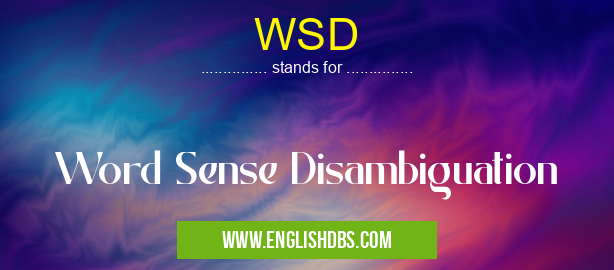What does WSD mean in GENERAL
Word Sense Disambiguation (WSD) is a technique used to distinguish between the different meanings of a word in natural language processing (NLP). It is an important part of understanding the meaning of a sentence and has been used to improve the accuracy of automatic machine translation. WSD algorithms are used to determine which meaning of a word is most appropriate in a particular context.

WSD meaning in General in Computing
WSD mostly used in an acronym General in Category Computing that means Word Sense Disambiguation
Shorthand: WSD,
Full Form: Word Sense Disambiguation
For more information of "Word Sense Disambiguation", see the section below.
What does WSD stand for?
WSD stands for Word Sense Disambiguation, which is a process that aims to determine the correct meaning of words given their context in natural language processing (NLP). WSD algorithms are often used to improve the accuracy and performance of automatic machine translation systems.
What is the Meaning of WSD?
The meaning of WSD is "Word Sense Disambiguation". This term refers to the process by which algorithms are used to determine which meaning of a word best matches its context, thus improving the accuracy and performance of natural language processing and automatic machine translation systems.
What is it Used For?
WSD algorithms are typically used to improve the accuracy and performance of natural language processing and automatic machine translation systems. By determining what sense or meaning best matches its context, these algorithms can ensure that words are being correctly interpreted and translated from one language into another. This can have far-reaching implications in terms of speech recognition, text comprehension, question answering, information retrieval, etc.
Essential Questions and Answers on Word Sense Disambiguation in "COMPUTING»GENERALCOMP"
What is Word Sense Disambiguation?
Word Sense Disambiguation (WSD) is the process of determining which sense of a given word is used in a sentence. This process involves using contextual information and semantic structures to identify and distinguish between different meanings of words. WSD algorithms try to assign the correct sense from a given text, allowing for language processing tasks such as machine translation and natural language understanding to be more accurate.
What are some applications of Word Sense Disambiguation?
Word Sense Disambiguation can be used in many applications, including automated indexing, information retrieval, machine translation, query-based document retrieval, parsing, natural language understanding, summarization and automatic text classification.
How does Word Sense Disambiguation work?
The basic idea behind WSD algorithms is to look at the context surrounding the word in question and use this to determine which sense of the word should be assigned. Different algorithms may use statistical models such as Naive Bayes or neural networks like Long Short-Term Memory networks in order to make this determination.
Why is Word Sense Disambiguation important?
WSD plays an important role in enabling machines to understand human language better by assigning the correct meaning to words. This allows for tasks such as machine translation and natural language understanding to be much more accurate and efficient than without it.
Are there any challenges when performing Word Sense Disambiguation?
One major challenge associated with performing WSD is polysemy - when a single word can have multiple meanings depending on context. This makes it difficult for WSD algorithms to accurately assign senses without enough contextual information about the usage of that particular word.
What type of data is needed for Word Sense Disambiguation tasks?
In order for WSD algorithms to work effectively, they need access to labeled datasets that contain examples of how certain words are used in various contexts. These datasets may include pre-labeled corpora or annotated texts which can then be used by algorithms for training purposes.
Does Word Sense Disambiguation require manual tagging?
In many cases manually labeling data for WSD tasks can take up valuable resources and time which could otherwise be spent on other areas of development or research. However depending on how large or advanced your dataset needs to be it may become necessary at times since manually annotating data provides very accurate results that automated methods might not otherwise achieve efficiently enough.
What methods are available for performing Word Sense Disambiguation automatically?
There are many approaches that can be taken when trying to automate the process of WSD including rule-based methods, supervised learning techniques such as Naive Bayes or Support Vector Machines (SVM), unsupervised clustering techniques like Latent Semantic Analysis (LSA) and more recently, deep learning networks such as Recurrent Neural Networks (RNNs) have also been used successfully with promising results.
Final Words:
To conclude, WSD stands for Word Sense Disambiguation - a technique used in natural language processing (NLP) that helps improve the accuracy and performance of automated machine translation systems by disambiguating words with multiple meanings depending on their context. Through its use, these systems can better understand sentences written in different languages and accurately convert them into another form.
